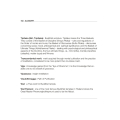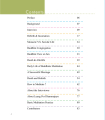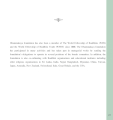Buddhist Dhamma : ค้นหาหนังสือธรรมะ หน้า 11 / 22
หน้าหนังสือทั้งหมด

77
The Enlightenment of Siddhattha Gotama
was himself freed. He lastly surveyed the process how birth inevitably leads to aging, sickness and death, which is a prelude to yet another birth – and one that will merely turn the Wheel of Life thr
This text recounts the journey of Siddhattha Gotama, who realized that life is a cycle of birth, aging, sickness, and death, culminating in his enlightenment as the Buddha. At dawn, he perceived the u

164
Characteristics of Fruitful Elderly Individuals
The second type of elderly person is called "A Fruitful
Person," a philanthropist or altruist.
Throughout their lives, these elderly people have
diligently earned their livelihood, and are well prepar
The text discusses the qualities of 'Fruitful Persons,' elderly individuals who exemplify self-sufficiency and altruism. They live by Buddhist principles, offer alms, adhere to precepts, and meditate

164
Understanding the Fruitful Elderly: A Guide to Altruism and Wisdom
The second type of elderly person is called “A Fruitful Person,” a philanthropist or altruist. Throughout their lives, these elderly people have diligently earned their livelihood, and are well prepar
The second type of elderly individual, termed 'A Fruitful Person', exemplifies philanthropy and self-sufficiency. These individuals have not only prepared well for their later years but have also enga

166
Understanding the Tipitaka and Buddhist Concepts
Tipitaka (Skt, Tripitaka): Buddhist scripture. Tipitaka means the Three Baskets. They consist of the Basket of Discipline (Vinaya Pitaka) – rules and regulations of the Order of monks and nuns; the Ba
Tipitaka, or Tripitaka, consists of three main sections: Vinaya Pitaka, Sutta Pitaka, and Abhidhamma Pitaka, covering monks' rules, discourses on various human concerns, and psychological aspects of B

124
Meetings with a Dhamma Master
Meetings with a Dhamma Master
is a more coarse way to judge good and/or bad, we might not have the best way but at least people can live with one another. In addition to custom or tradition, we can a
The text explores how good and bad actions are judged in Buddhism, emphasizing the importance of intention in determining Kamma. It reflects on the historical context of societal divisions due to misu

43
National Dhamma Quiz Contest
The text in the image is:
"National Dhamma Quiz Contest
The Dhamamkaya Foundation in co-operation with the International Buddhist Club have arranged a yearly peace and ethics education curriculum wh
The Dhamamkaya Foundation, with the International Buddhist Club, organizes a yearly peace and ethics education curriculum that features a quiz contest for schoolchildren, university students, and mili

69
Success of Moral Training Projects: Dhammadayada Program
ASE HISTORY OF THE SUCCESS OF MORAL TRAINING PROJECTS
The Dnammadayada (Dhamma Inheritors) Training Programme has been conducted for twenty-seven years since the beginning of the Dhammikaya Foundatio
The Dhammadayada Training Programme has operated for twenty-seven years, focusing on hands-on Buddhist practice for students. In 1996, the program was scientifically assessed, revealing that participa

184
The Dhammakaya Temple and the Dilemma of Abandoned Temples in Thailand
Of course, people closely followed the news about the
Temple. After two years, the outcome was the reverse.
Unbelievably, the Temple has survived to this day. Many said
that in the same period of time
In recent years, the Dhammakaya Temple has faced severe media scrutiny yet continues to attract thousands to its ceremonies, indicating a strong community support unlike the fate of many abandoned tem

4
Exploring Buddhism: Key Insights and Practices
4
Contents
Preface
Background
Interview
06
07
09
Rebirth & Incarnation
17
Monastic V.S. Secular Life
24
Buddhist Congregation
30
Buddhist View on Sex
33
Death & Afterlife
39
Daily Life of Buddhists Me
This content provides an overview of significant topics in Buddhism such as the concepts of rebirth and incarnation, the differences between monastic and secular life, and the Buddhist perspective on

7
Wisdom of Luang Phaw: Sayings on Meditation and Life
Preface
This is a collection of some of the sayings given by Luang Phaw
the period 1988-2000. It must be said that this book is one of the
first examples of his work to appear in English. The book's c
This book features a compilation of sayings by Luang Phaw from 1988-2000, marking one of the first appearances of his teachings in English. Initially published in Thai as 'Kong Kwan' in 2000, the sele

177
Dhammakaya Foundation and Its Global Engagement
Dhammakaya foundation has also been a member of The World Fellowship of Buddhists (WFB) and the World Fellowship of Buddhist Youth (WFBY) since 1986. The Dhammakaya foundation has participated in many
Dhammakaya Foundation has been a member of The World Fellowship of Buddhists (WFB) and the World Fellowship of Buddhist Youth (WFBY) since 1986. The foundation actively participates in various activit

1
Tomorrow The World Will Change
Luang Phaw Dhammajayo was born in Singburi Province, Thailand in 1944. Backed with deep interests in Buddhism and meditation, he was ordained as a Buddhist monk at the age of 25 at Wat Paknam Bhasicha
Luang Phaw Dhammajayo, a prominent Buddhist monk from Thailand, advocates for world peace through inner peace and meditation. He emphasizes that true happiness is attainable and essential for achievin

147
Ordaining for One’s Parents Brings Merit
Chapter 35
Ordaining for One’s Parents Brings Merit
In this day and age of ever-present temptations and perpetual pressure to make a living, it is especially rare to find any family with a son who or
Chapter 35 discusses the rarity and importance of a son ordaining as a monk during Buddhist Lent. It highlights that such a decision reflects the virtue of the family and the son's commitment rather t

182
Characteristics of a True Buddhist
are like any of them and if we have performed our duties as true Buddhists yet or not.
A true Buddhist must exhibit the following characteristics:
1) Belief in the Lord Buddha’s Enlightenment. It is
This text outlines the defining characteristics of a true Buddhist, emphasizing belief in the Lord Buddha's Enlightenment, adherence to the 5 precepts, understanding the Law of Kamma, and maintaining

184
Dhammakaya Temple and the Challenge of Abandoned Temples in Thailand
Of course, people closely followed the news about the Temple. After two years, the outcome was the reverse. Unbelievably, the Temple has survived to this day. Many said that in the same period of time
The Dhammakaya Temple has remarkably survived against media backlash, drawing nearly 100,000 attendees to its ceremonies, despite allegations of bribery. Meanwhile, a concerning trend of temple abando

21
Exploring Buddhist Manuscripts and Teachings
JDIRI
Contents
The Most Venerable Phrathepyanmahami (Luang Phaw Dhammajayo)
*Homily* I
Garry W. Trompf
Emeritus Professor in the History of Ideas
This text presents a collection of scholarly articles on Buddhist manuscripts and teachings, focusing on contributions from various experts. It includes studies on the Tipitaka Manuscripts of the Kham

120
An Shigao and Early Chinese Meditation Techniques
An Shigao and Early Chinese Meditation Techniques¹
Phra Kiattisak Kittipanyo² (University of Otago)
An Shigao安世高 (147~168 CE) played an important role in the early transmission of Buddhism into China
An Shigao (147-168 CE) significantly influenced the early transmission of Buddhism in China. Despite a focus on his ethnicity and translation style, he is recognized as a respected meditation master.

126
An Shigao's Influence on Anban Sutras
From Sengyou’s CSZJJ, we learn that there are two Anban[shouyi] jing sutras which were translated by An Shigao:37
安般守意經一卷 安錄云:『小安般經』。(CSZJJ p.5c 23: “corresponding to a Smaller Anban jing”
大安般經一卷(CSZJ
This content examines An Shigao's translations of Anban sutras, highlighting the distinctions between the Present Da Anban shouyi jing and the Kongo-ji Anban shouyi jing. The text discusses the integr

127
The Practice of Ānāpānasmṛti: Breath Meditation in Early Buddhism
describing the practice of the four smrtyṣhānas associated with the breath (ānāpānasmṛti), and resulting the attainment of the three vimoksamukhās.42
An Shigao’s translation of the Ānāpānasmṛti Sūtra
This text delves into the practice of Ānāpānasmṛti, a significant Buddhist meditation focused on breath. It highlights An Shigao’s translation of the Ānāpānasmṛti Sūtra and its influence on later monk

63
คัมภีร์คาถาธรรมในชุดของโบราณติและมาร์ติน สโคเย่น
6.1.2. คัมภีร์คาถาธรรมในชุดของ โบราณติ ซีเนียร์ (Senior collection) อายุรวาพุทธศตวรรษที่ 7
คัมภีร์ในสองชุดนี้ ศึกษาจากที่ที่พิมพ์ในชุด Gandharan Buddhist Texts (GBT) และสิ่งพิมพ์ที่เกี่ยวข้อง
6.1.3. ค
คัมภีร์คาถาธรรมในชุดโบราณติและมาร์ติน สโคเย่น มีต้นกำเนิดอายุระหว่างพุทธศตวรรษที่ 6-12 แบ่งออกเป็นหลายชุด รวมถึงคัมภีร์จากญี่ปุ่นและเขตบาโจว์ ปากิสถาน โดยศึกษาจากงานพิมพ์และภาพถ่ายดิจิตอลที่เกี่ยวข้อง
